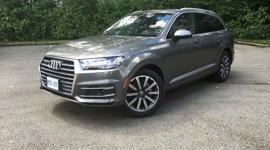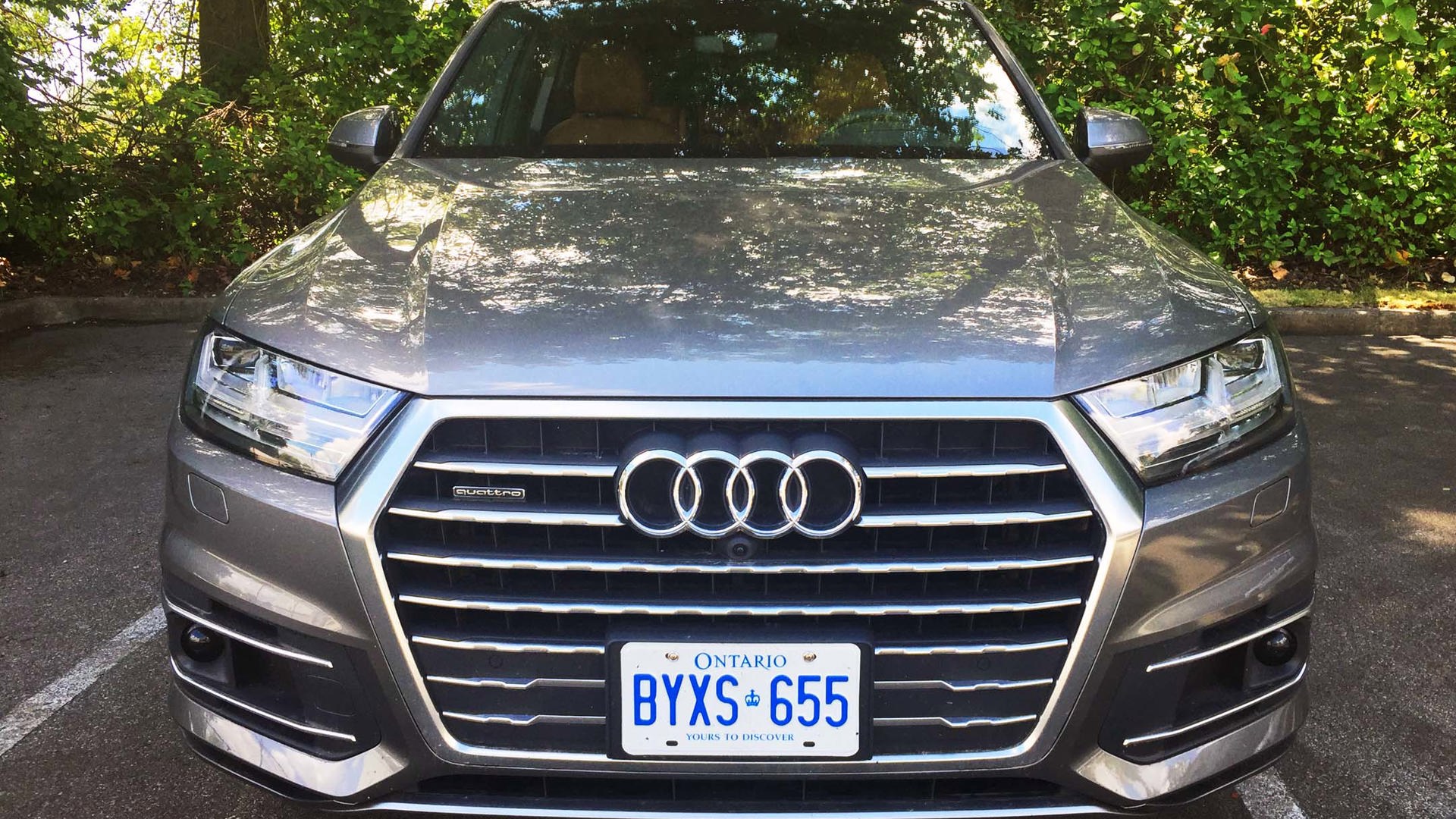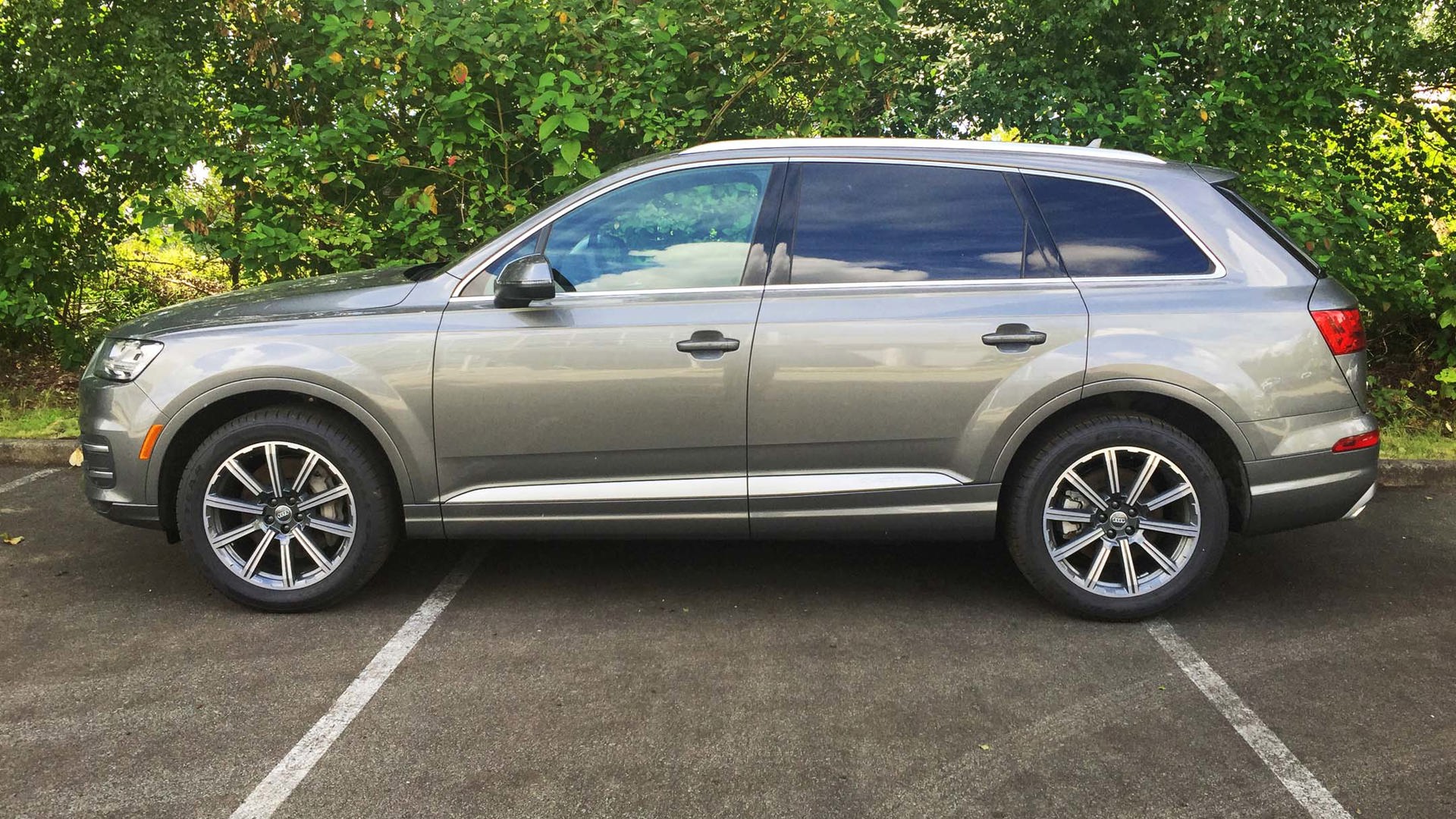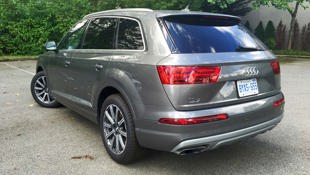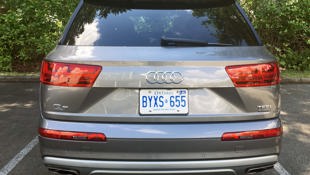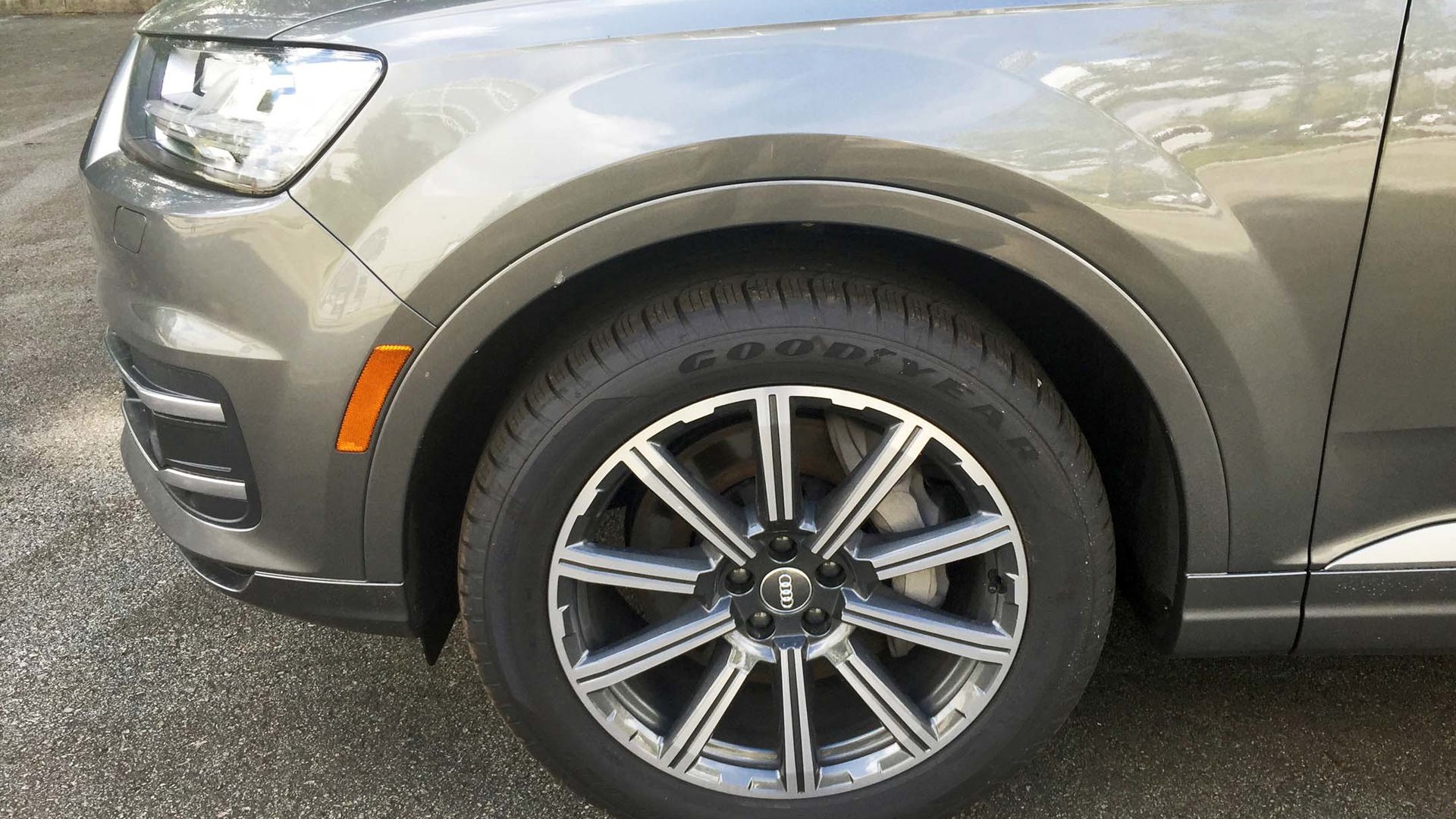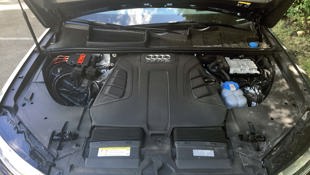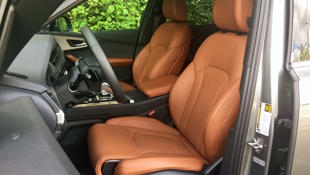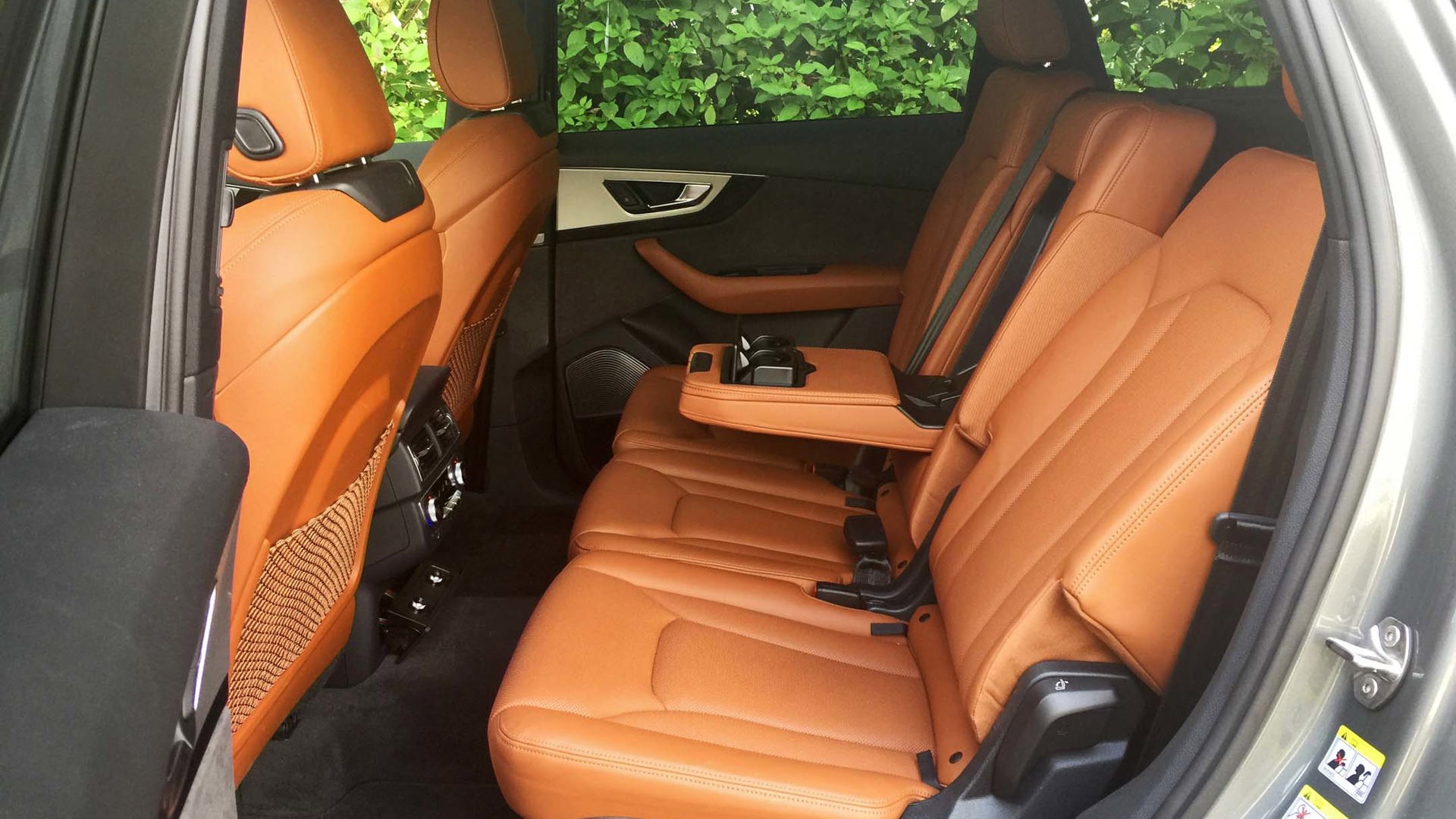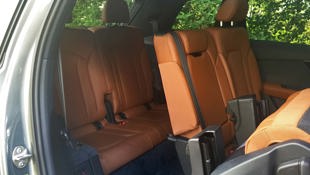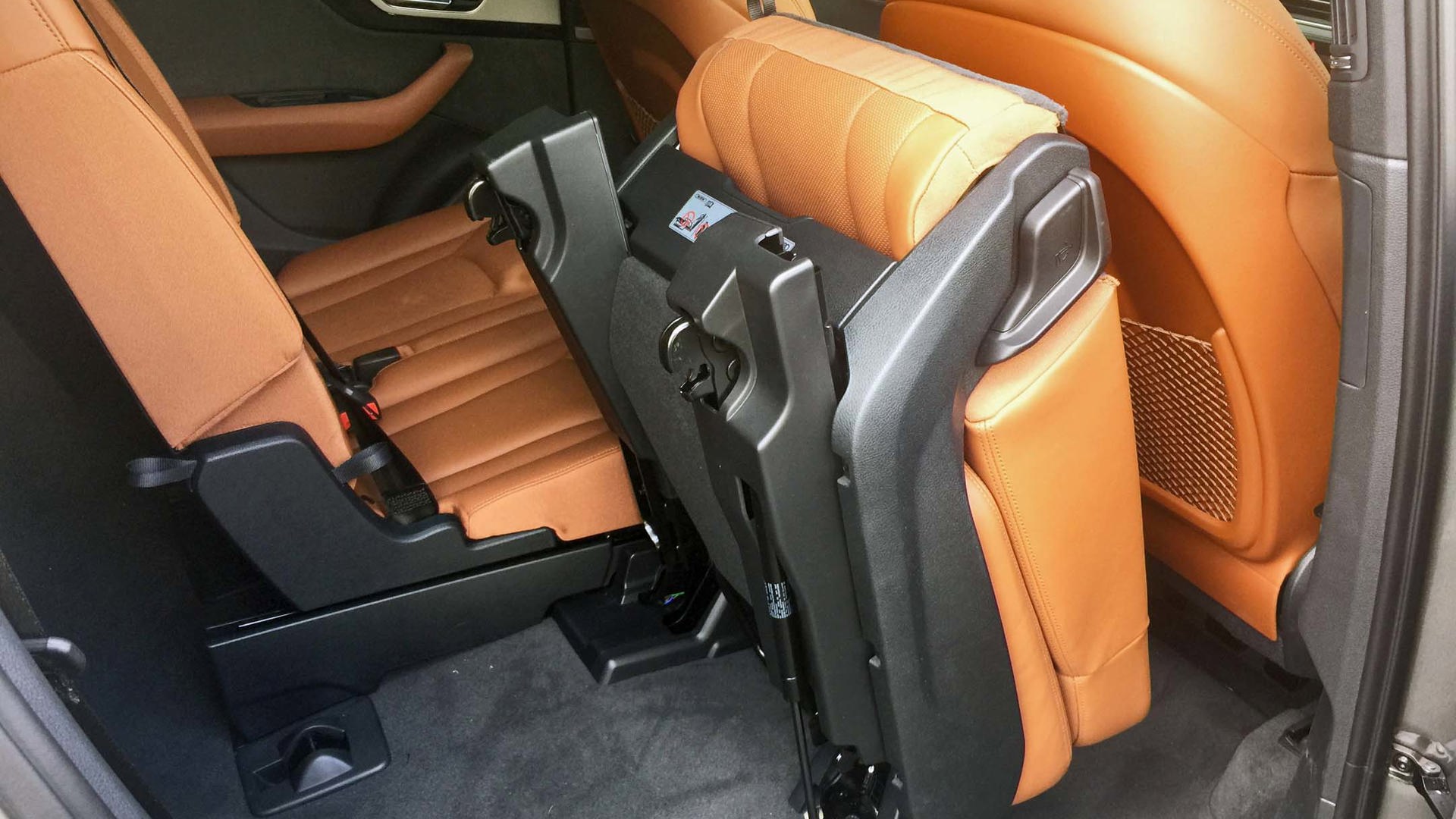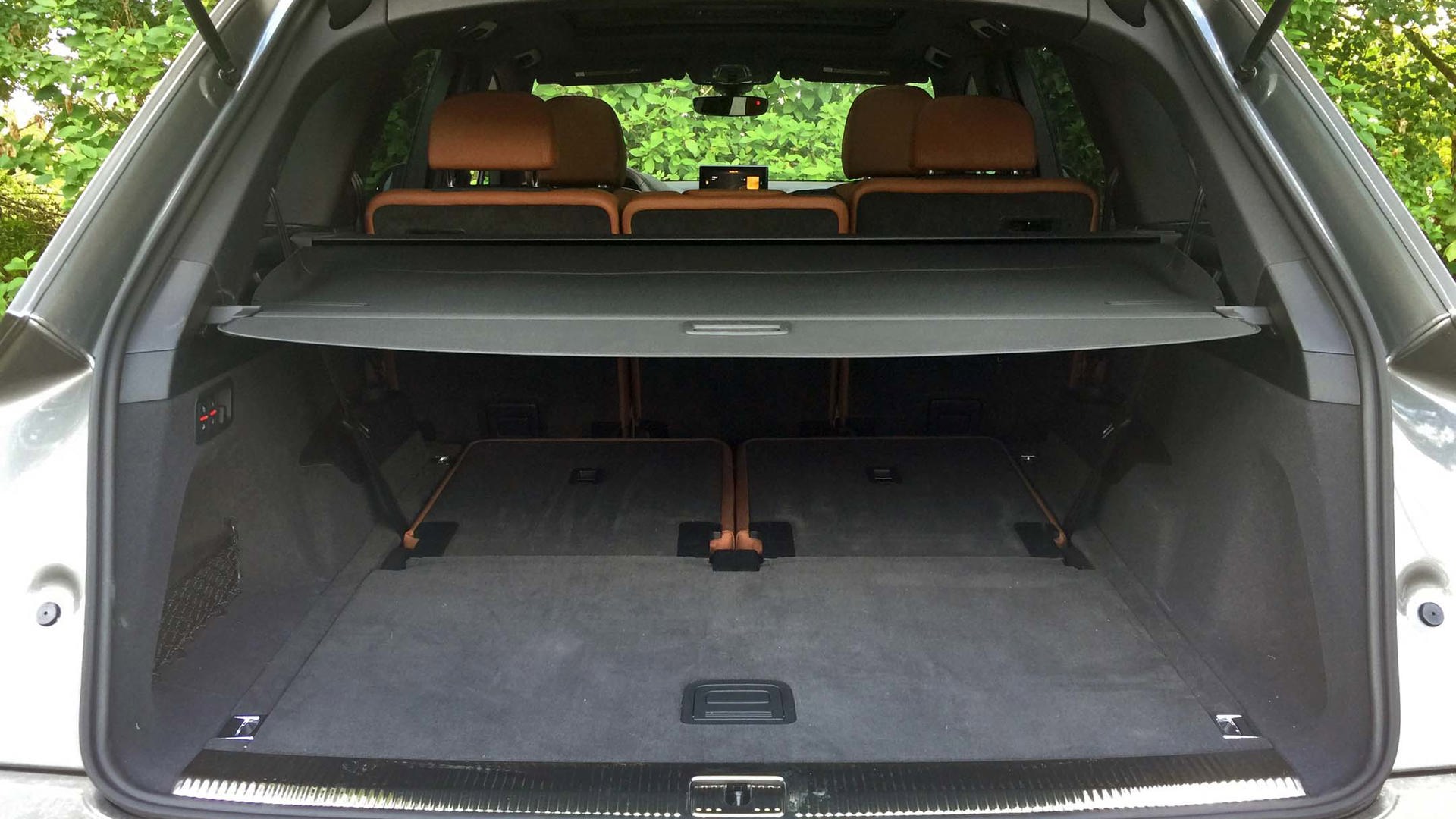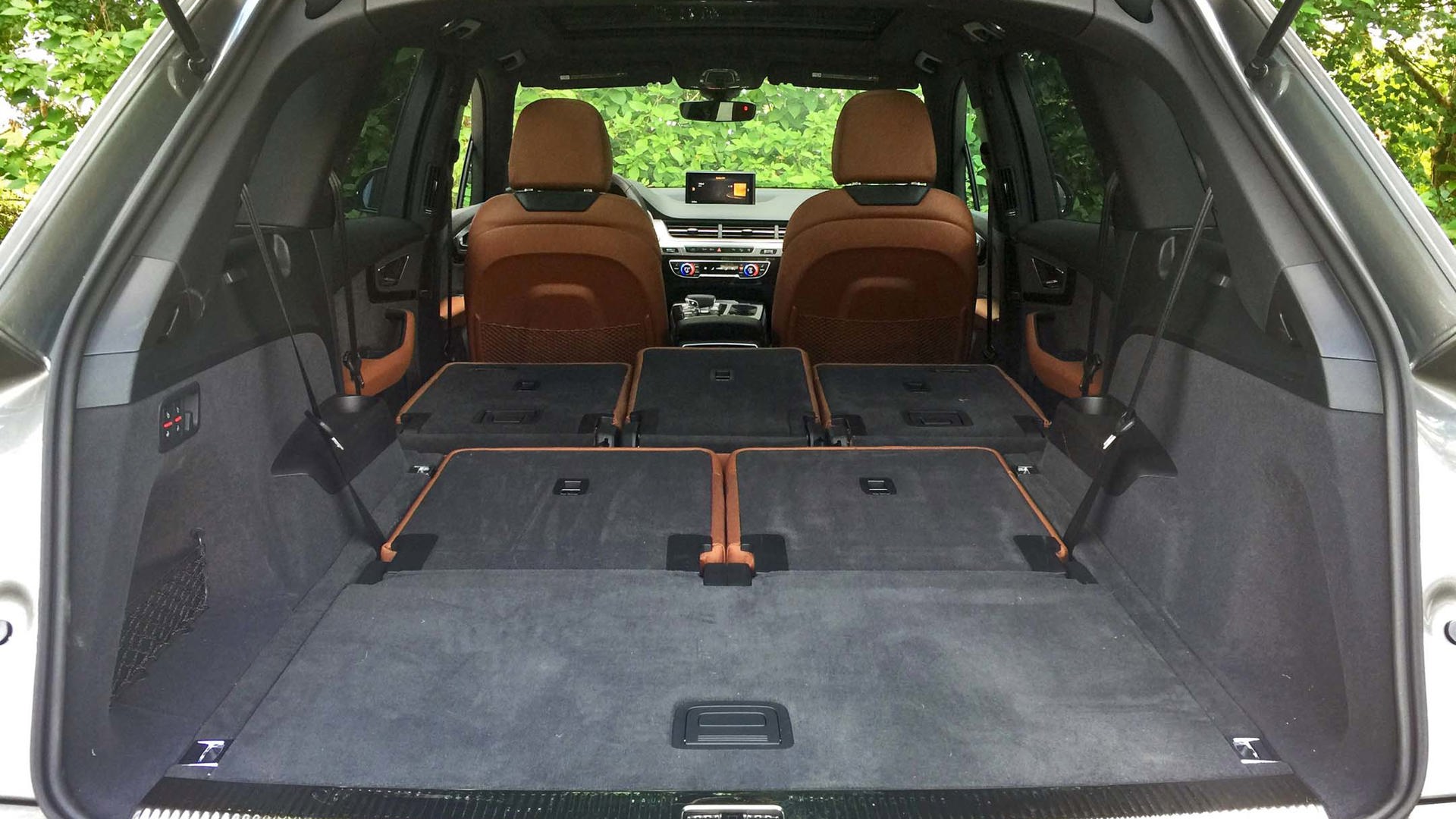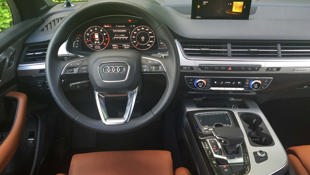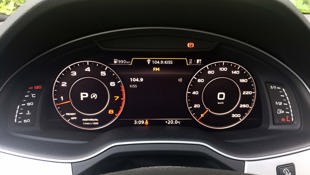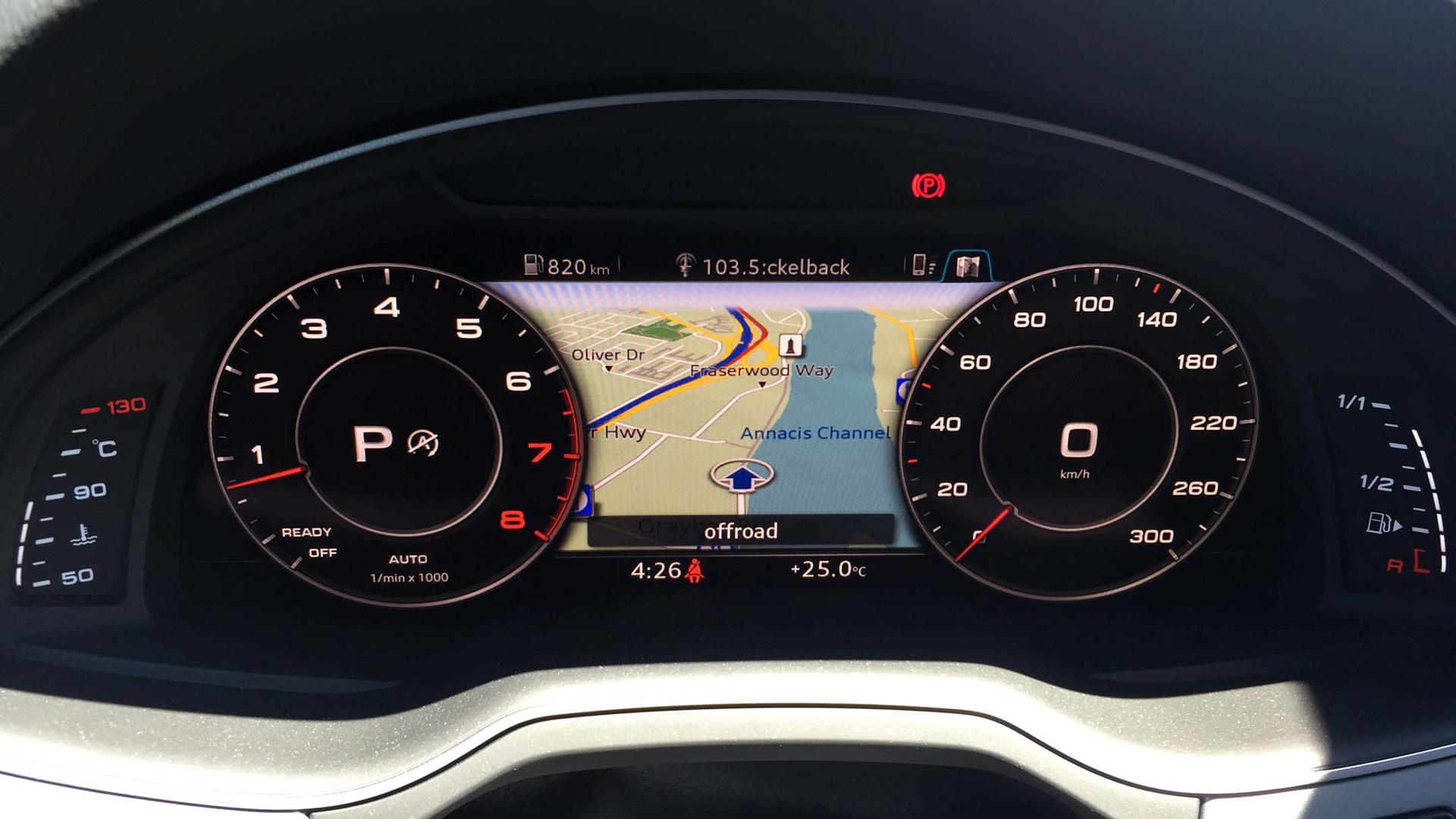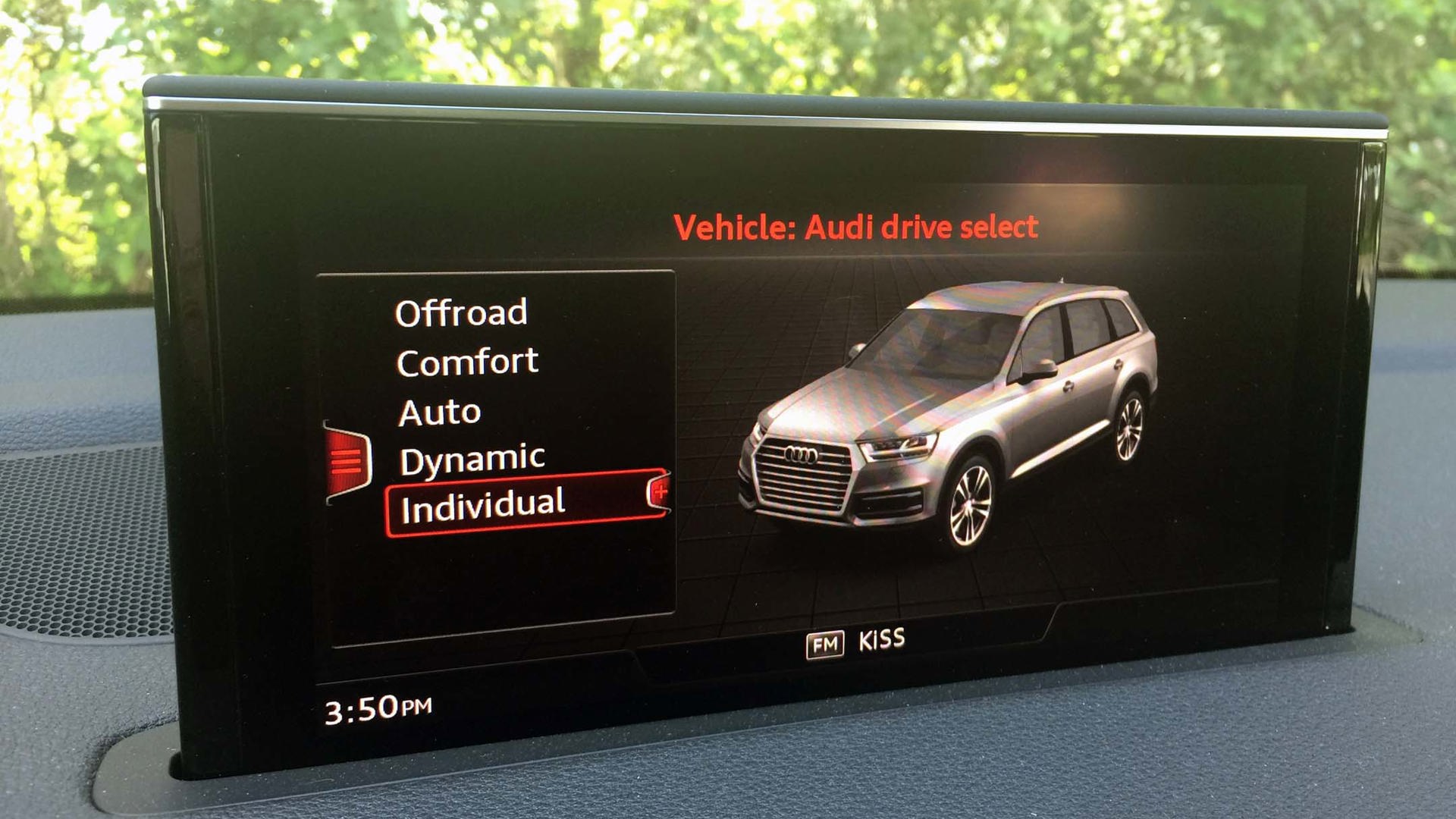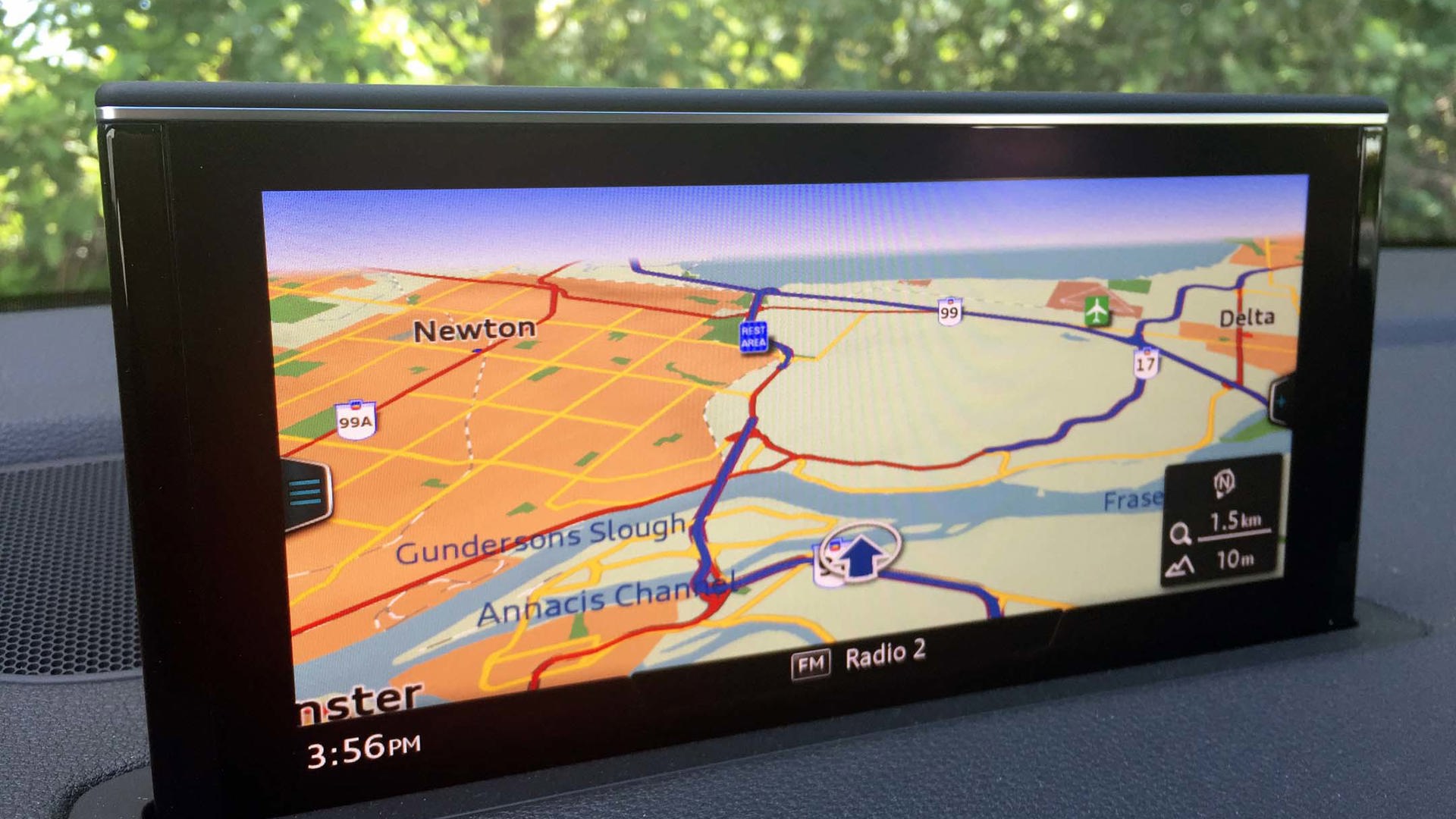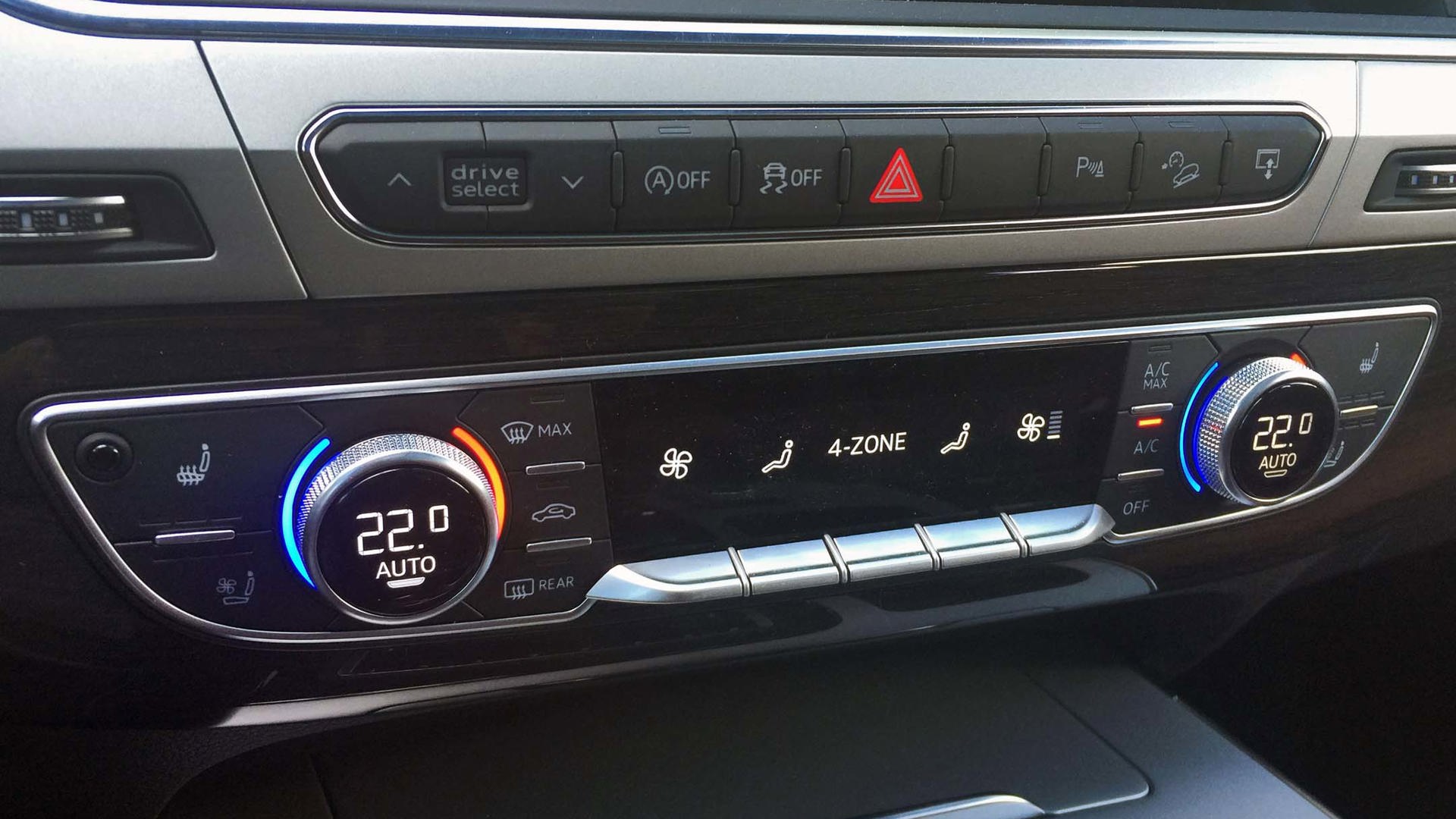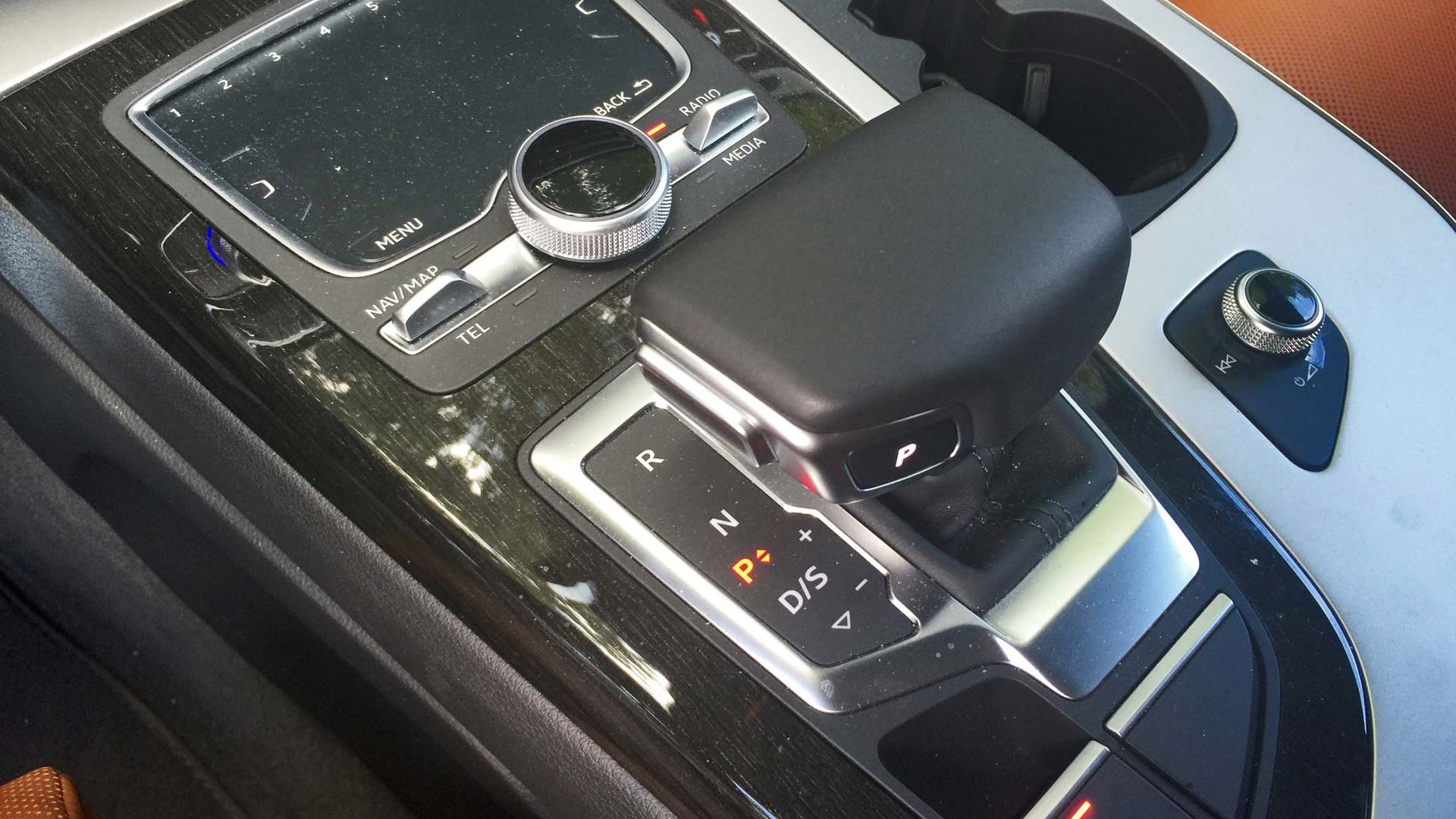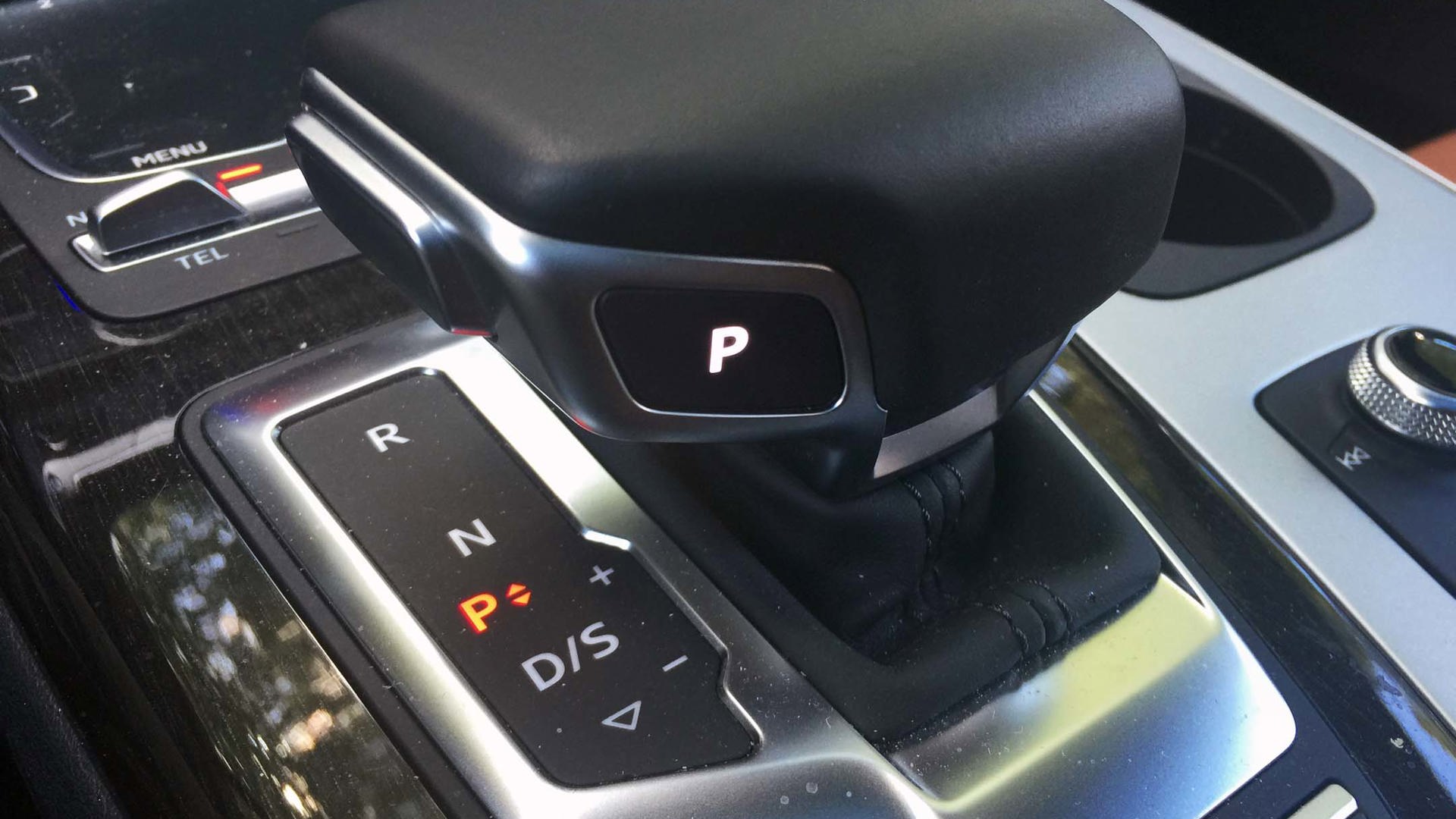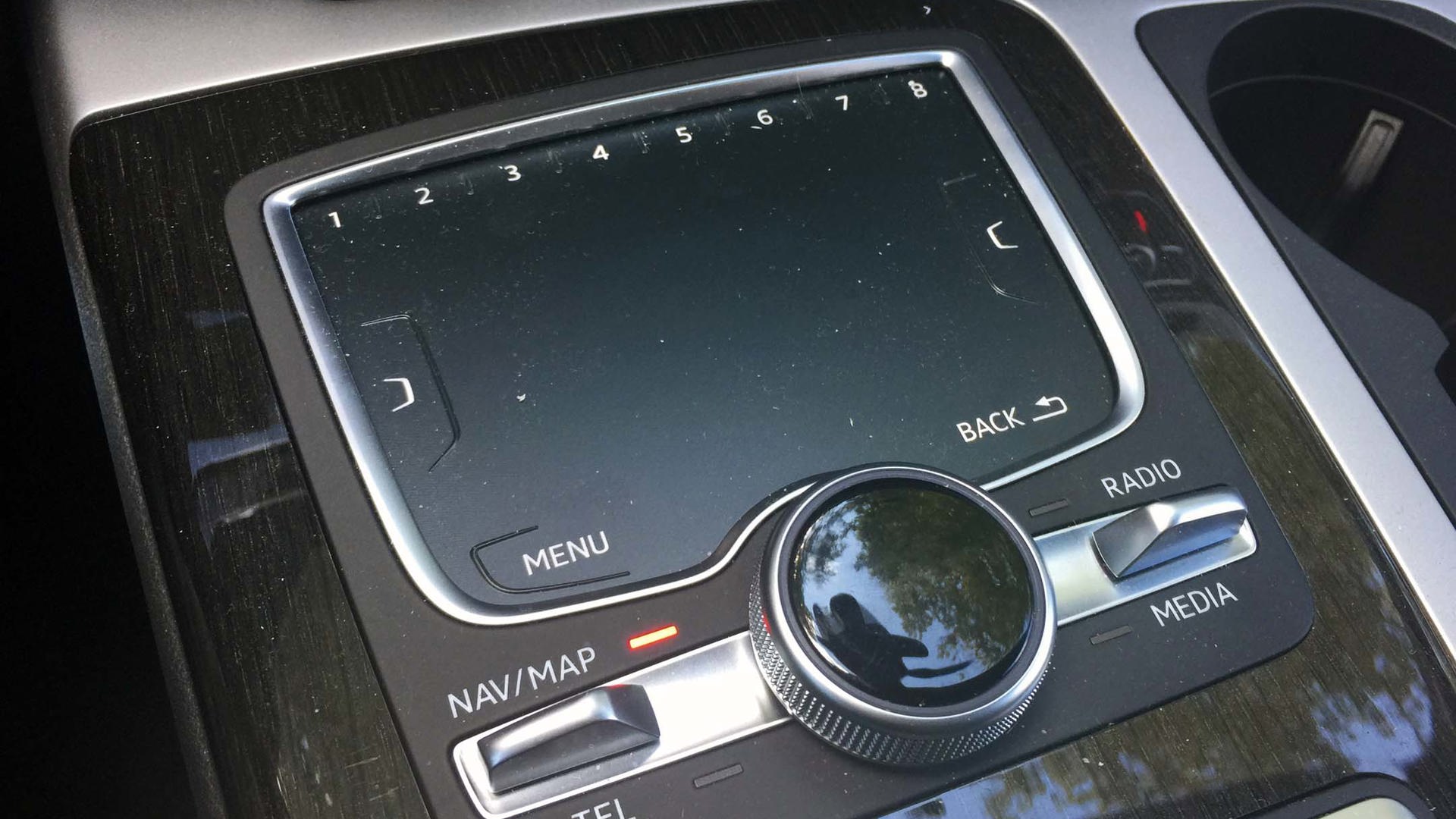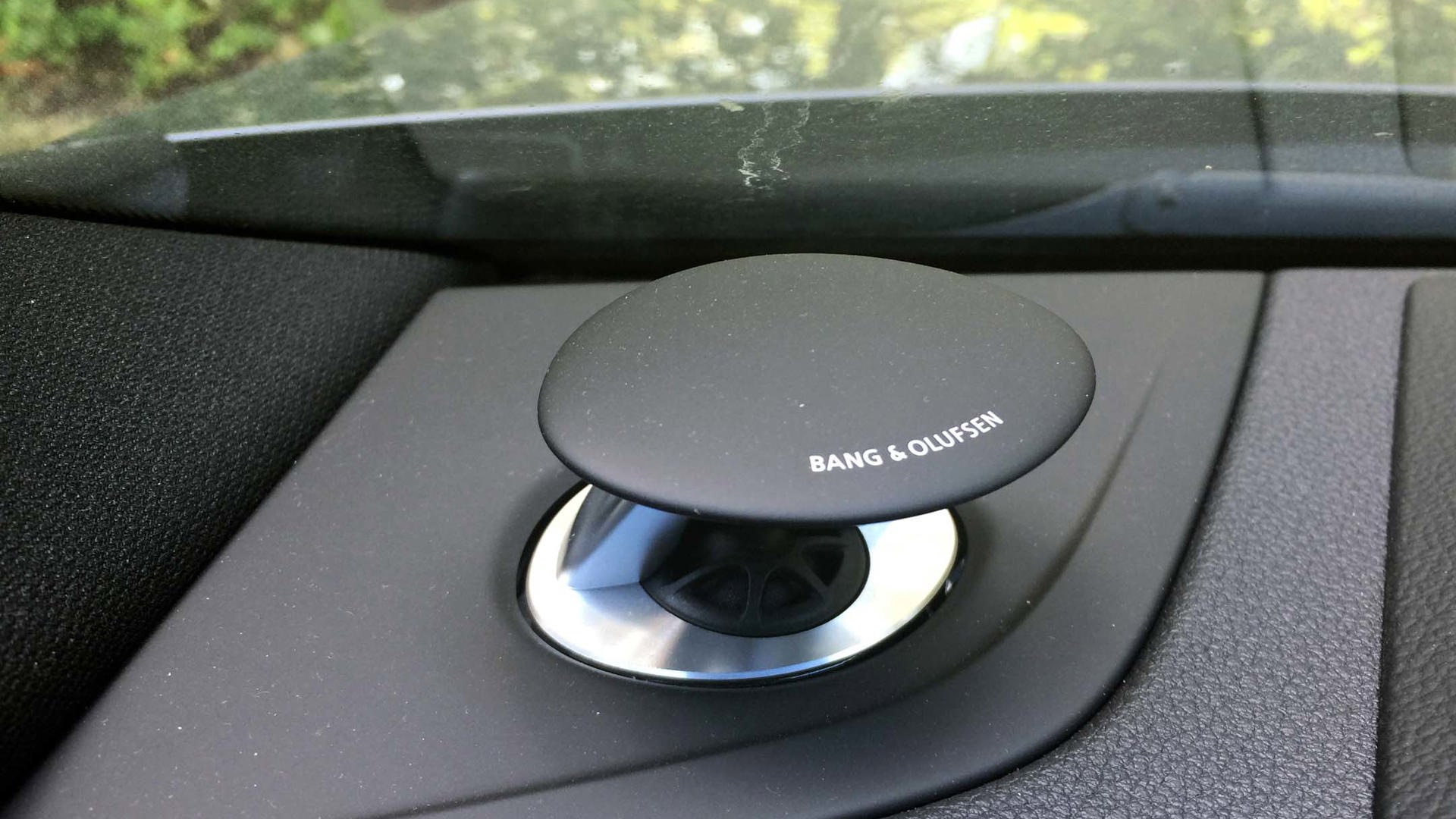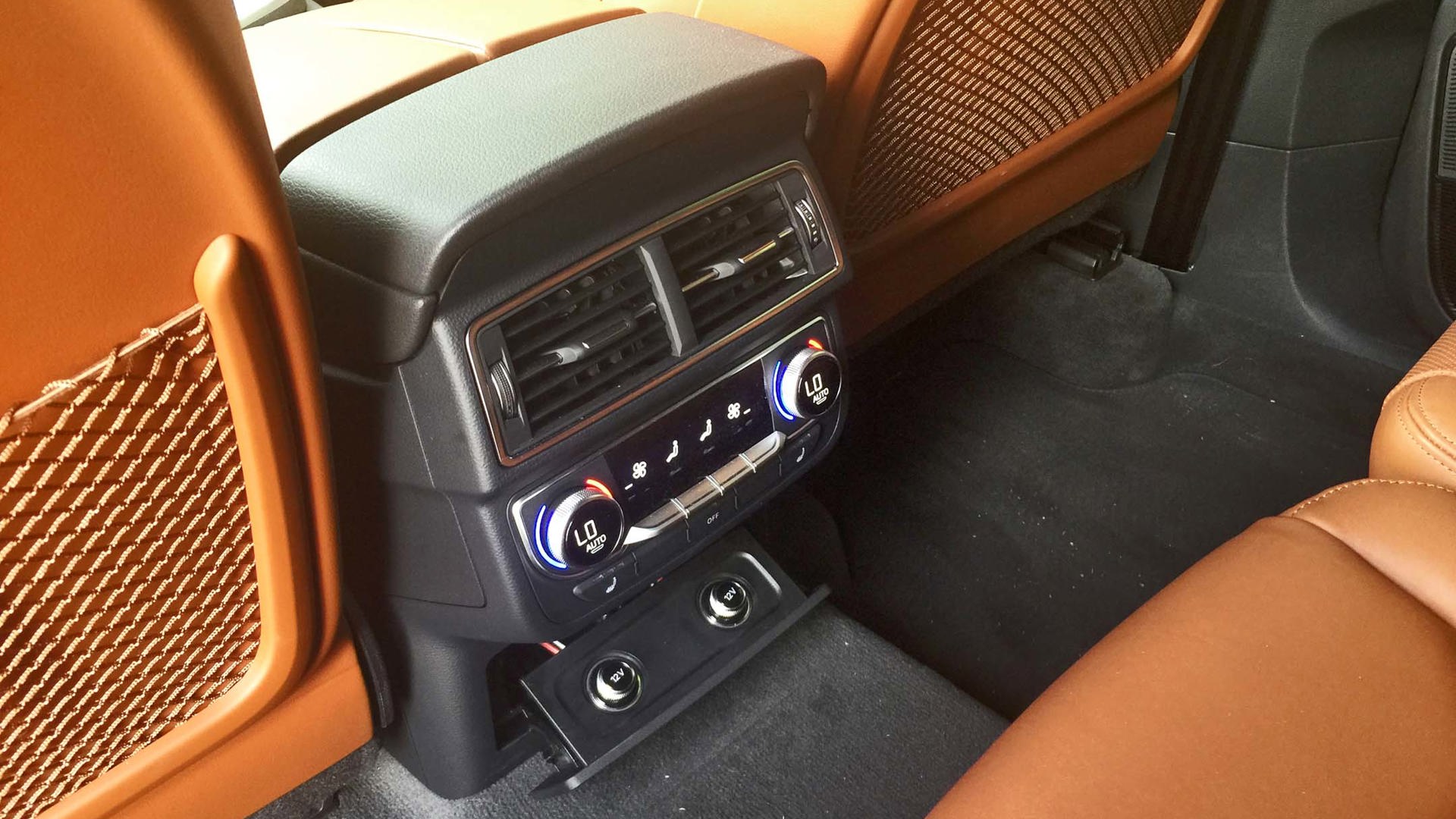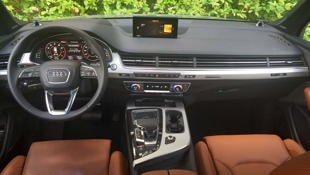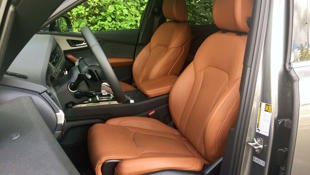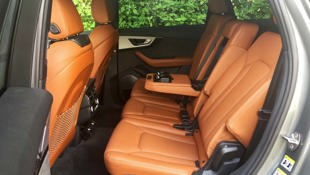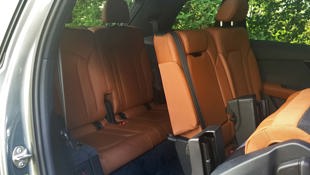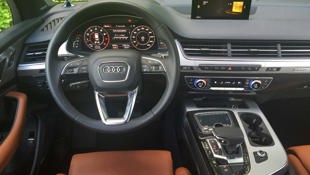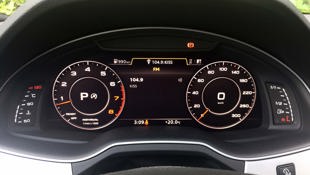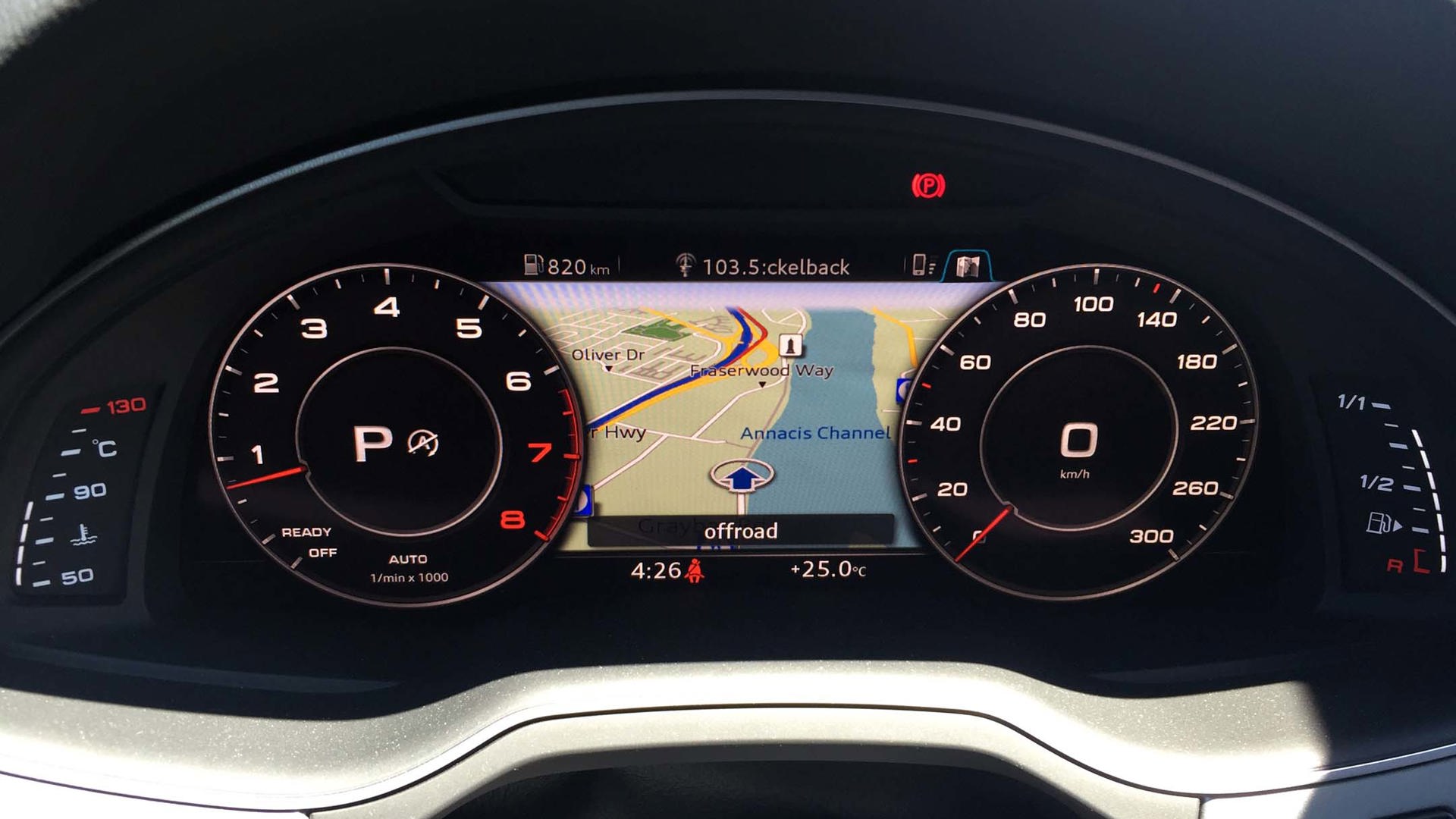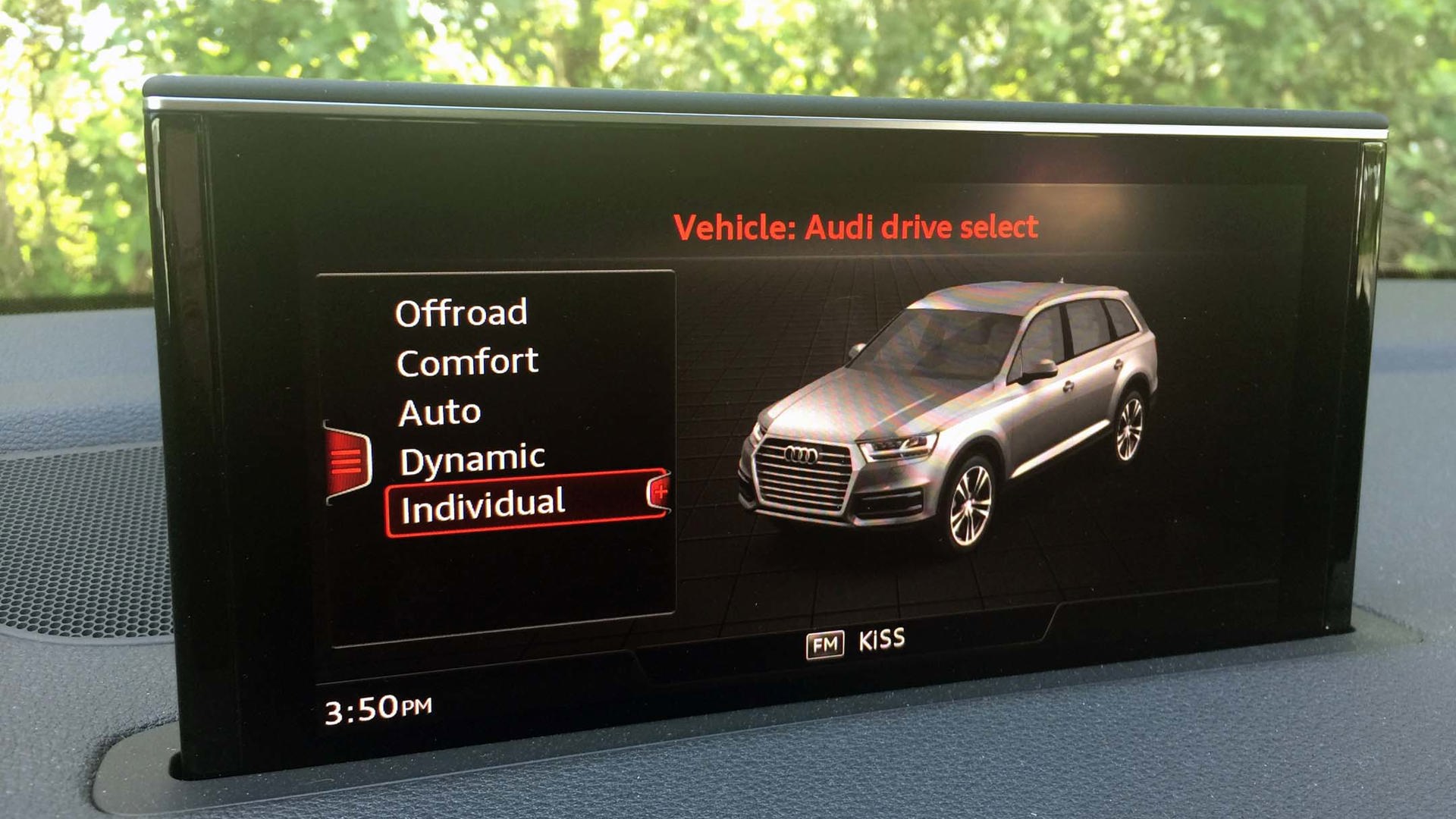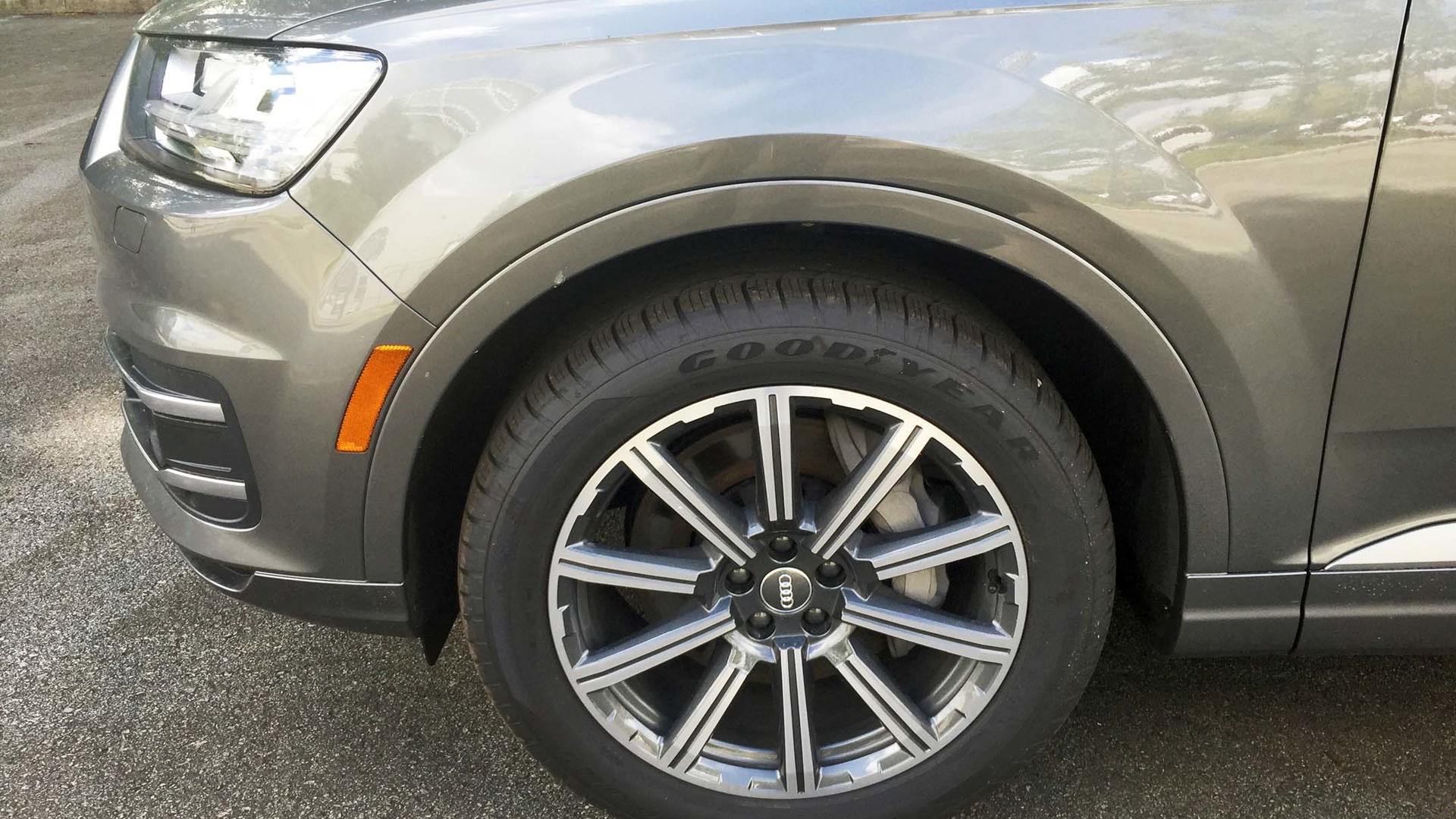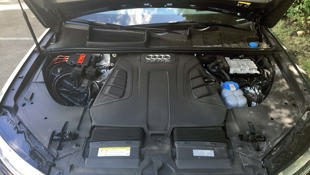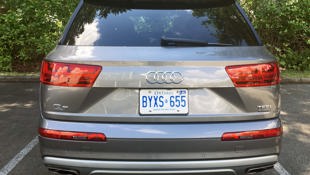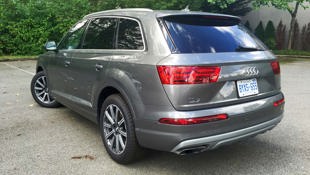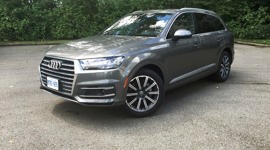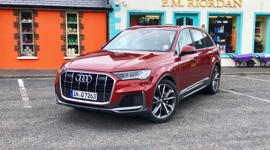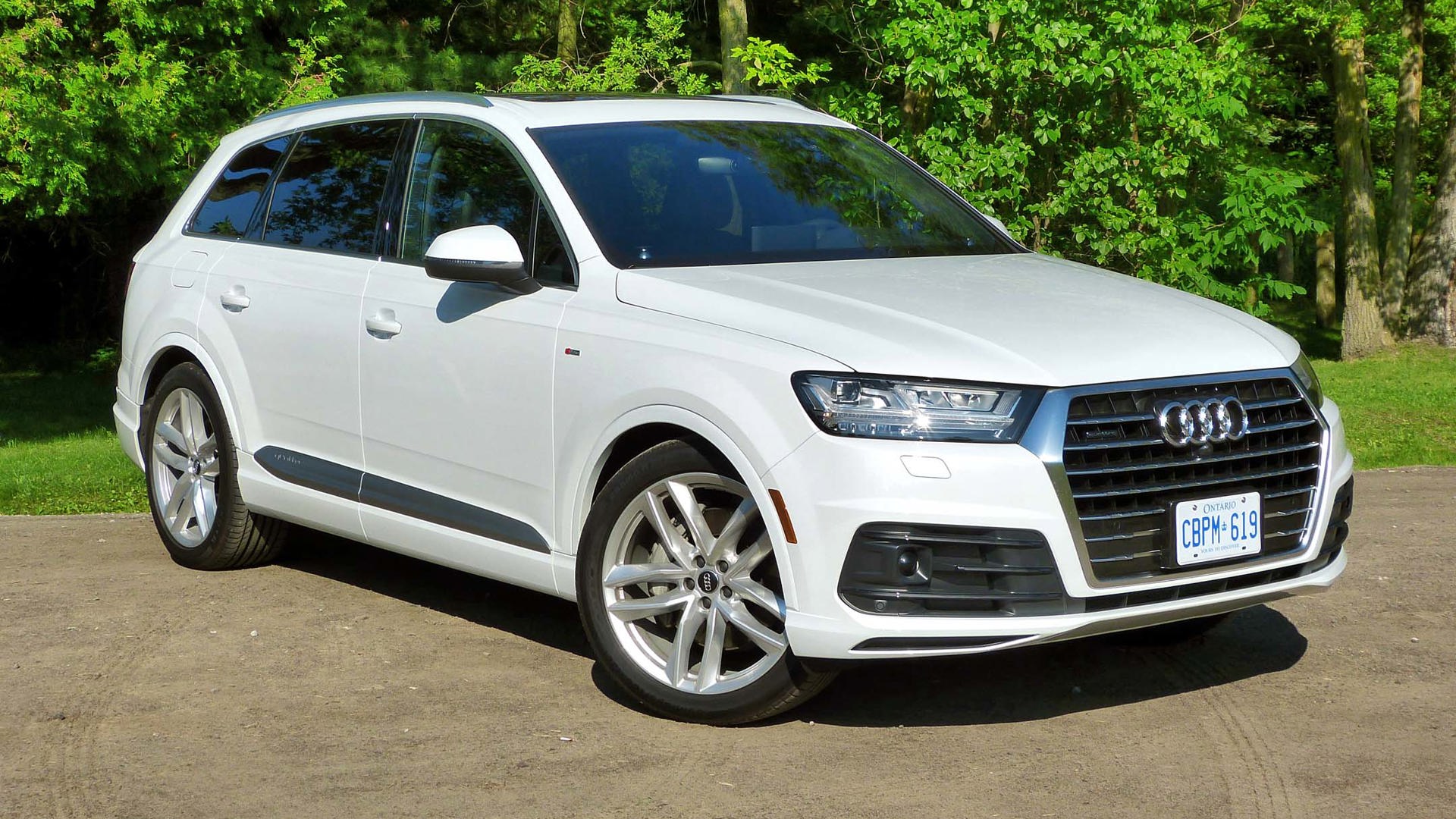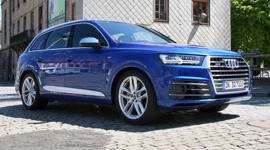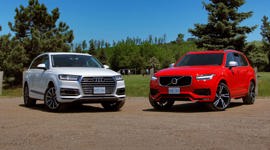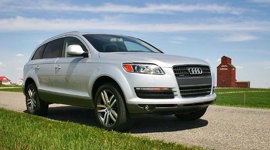 AutoTrader SCORE
AutoTrader SCORE
-
STYLING6/10
-
Safety9/10
-
PRACTICALITY9/10
-
USER-FRIENDLINESS8/10
-
FEATURES8/10
-
POWER8/10
-
COMFORT8/10
-
DRIVING FEEL7/10
-
FUEL ECONOMY7/10
-
VALUE7/10
Now with crisper lines and an imposing six-sided grille with seven horizontal bars, the newly redesigned 2017 Q7 joins other new Audis in embracing Audi’s sharper design theme. But while there is a certain business-like seriousness about the new Q7’s sharp body creases and the “don’t-mess-with-me” boldness about its extra-large grille, the Q7’s shape is slightly less adventurous while its oversized grille is really, well, oversized. What is it with Audi and big grilles?
Styling preferences aside, it’s the changes under the Q7’s sheet metal that are more significant. Thanks to the increased use of lightweight aluminum and a new lighter-weight five-link rear suspension, the 2017 Audi Q7 is now over 200 kg lighter than the previous Q7. So even though the 2017 model has the same 333 hp supercharged 3.0L V6 engine and eight-speed automatic transmission as its predecessor, the 2017 Q7’s fuel economy has improved by about 16 percent, according to Transport Canada figures. The 2017 model rates 12.6 / 9.4 /11.1 L/100 km (city / highway / combined) while the previous Q7 rated 15.2 / 11.0 / 13.3. During my week of mixed city and highway driving, I averaged 11.0 L/100 km, close to the official NRCan combined rating. Note that the Q7’s engine requires premium unleaded gas.
The Q7’s improvement in urban fuel economy can be partly attributed to its new auto-start/stop system which automatically shuts off the engine while paused at traffic lights and restarts it when the brake pedal is released. This saves a lot of gas in stop-and-go city traffic. During my test drive, I found the frequent stopping and starting of the engine noticeable but not objectionable. It can be deactivated if you don’t like it.
With less weight to pull around, the 2017 Q7 is quicker than the last one. While the previous Q7 did 0 to 60 mph in 6.9 seconds, the new Q7 zips to 60 mph in just 5.7 seconds, according to Audi-supplied figures. That’s pretty darn quick for a 2,240 kg (4,938 lb) seven-passenger SUV.
The Q7’s standard supercharged 3.0L DOHC, 24-valve V6 with direct injection pumps out a healthy 333 hp from 5,500 to 6,500 rpm and 325 lb-ft of torque between 2,900 and 5,300 rpm. It’s a very smooth, powerful, rorty engine and has an equally smooth partner in the standard sight-speed automatic (Tiptronic) transmission which includes sequential manual shift capability using the shift lever or paddles behind the steering wheel. Smooth and quiet on the highway, the engine turns over just 1,500 rpm at a steady 100 km/h in eigth gear for comfortable cruising.
All Q7s include a driver-selectable Sport mode which delays upshifts and generally keeps the engine revving higher for quicker throttle response and better performance. As well, the generous torque of the supercharged engine contributes to a maximum towing capacity of 3,492 kg (7,700 lb) making the Q7 appealing to recreational users with boats and trailers. An optional towing package with seven-pin adaptor is priced at $550.
One thing you’ll need to work out before you go anywhere is the Q7’s transmission shift design. Instead of P, R, N, D/S, the sequence is now R, N, P, D/S. Park is in the middle of the sequence, so you have to move the lever back one step to engage Drive/Sport or move the lever forwards once to engage Neutral or twice to engage Reverse. Park is engaged by pressing a button on the shift handle. Because of the sequential shifter and the unusual gear arrangement, it’s a bit confusing at first. You have to forget about the traditional P, R, N, D layout that you’ve been using for years. Personally, I think the old arrangement is simpler and the new shift design is unnecessarily complicated.
To suit different drivers’ driving styles, 2017 Q7s come standard with Audi Drive Select which provides up to seven different driver-selectable driving modes that vary throttle, transmission and steering settings. All Q7s include Comfort, Efficiency, Auto, Individual, and Dynamic modes and, when equipped with the optional air suspension in the Dynamic Ride Package ($3,900), two additional modes: Allroad, which increases ground clearance by 25 mm and Lift which increases ground clearance by 60 mm. The Dynamic Ride Package also includes four-wheel steering for tighter U-turns and more precise manoeuvring.
During my week of mixed city and highway driving, I didn’t detect a big difference between Comfort and Efficiency modes, but the Dynamic mode sharpens throttle response off the line, holds gears longer, makes shifts quicker and firms up the steering noticeably. I would recommend selecting Efficiency for maximum fuel economy, Comfort or Auto for daily driving, and Dynamic for driving performance. And if you venture off-road or want extra clearance in winter, the optional Dynamic Ride Package might be worth the additional $3,900.
Though it’s a big, heavy SUV, the Q7 is easy to drive and feels very stable when cornering. The Q7’s ride is very comfortable and quiet on the freeway and road imperfections are absorbed without any body creaks or suspension rattling. Speed-sensitive power steering is responsive while requiring minimal effort; however, the Q7’s turning diameter of 12.4 m (40.7 ft) is wide. I’m told that models with the optional four-wheel steering have a smaller turning circle.
The driver sits up tall and has excellent visibility, aided by a parking camera that includes four different views around the car as well as a 360-degree top-down view. This is very useful when parking in tight spots. Rear parking sensors are standard but there are no front parking sensors.
All Q7s include Audi Side Assist (blind-spot warning) which monitors the areas beside and behind the car and flashes a warning light in the outside mirrors to warn of potential collisions. For 2017, advanced safety features now include Active Lane Assist and Adaptive Cruise Control with Stop & Go Traffic Jam Assistant. Using cameras and radar sensors, the Q7 can maintain a steady distance to the car ahead and brake or speed up automatically if necessary. It can also warn the driver if they are drifting out of their lane and automatically steer the Q7 back into its lane. These optional driver assistance features are available as part of the Driver Assistance Plus Package ($3,400) on some trim levels.
With winter approaching, I’m reminded that the Q7 has the right stuff to handle inclement weather. Its standard quattro all-wheel drive, high ground clearance, big (18- to 21-inch) tires, four-wheel disc brakes, xenon headlights, and new driver-assistance safety features are designed to compensate for all kinds of weather and road conditions. The quattro system with its self-locking centre differential varies torque front to rear up to 100 percent providing instantaneous and barely discernible all-wheel drive traction and stability.
As good as the Q7’s performance and engineering is, I suspect that many buyers will base their purchasing decision simply on the Q7’s luxurious and high-tech interior. The quality of the materials and overall design is top-class. Now with a more horizontal design theme using a classy combination of leather, aluminum, chrome, suede and soft-touch plastics, the cabin of the 2017 Q7 has an expensive look and feel – probably not too surprising since Audi has always made great interiors.
New for 2017 is an available 12.3-inch instrument display behind the steering wheel that replaces the standard gauge cluster. This electronic display can be configured two ways: with two large round gauges and a smaller central information display, or with two small round gauges and a large central info display that can include a real-time navigation map. It’s bright and easy to read and because it’s shielded under an overhanging hood, it doesn’t suffer from the sun glare that can make the centre dash screen difficult to see.
That centre dash screen slides up from the dash each time the Q7 is started and retreats when not in use, but it can be left up all the time if desired. Using the console dial or the “fingertip writing pad” in front of the shift lever, the driver can select different menus on the dash screen such as telephone, navigation, audio, and it also serves as a display for the 360-degree cameras and a rear-view camera display when in Reverse gear. The four-zone automatic climate control, however, is separate from the controller and screen display with its own traditional round dials and buttons. Second-row passengers have their own climate controls.
My top-of-the-line Q7 Technik model had heated and cooled front seats with the massage feature. Using a button on the side of either front seat, the occupant can choose a pulsating, wave or stretching seatback massage that targets the upper, middle or lower back and sides. This could be especially beneficial on a long drive or perhaps after “a hard day at the office” but it is also somewhat distracting while driving. It’s only available on the top Technik trim as part of the optional Luxury Package ($3,750) which also includes Valcona leather, contour seats, ventilated front seats and power door closers.
While being massaged, Q7 occupants can enjoy the standard 180 watt audio system with 11 speakers (Komfort and Progressiv trims) or the optional Bose 3D sound system with 550 watts and 19 speakers (Progressiv); or if you have an extra $5,100, you can opt for the optional Bang & Olufsen 3D Advanced Sound System with 1,920 watts (Technik). My vehicle was equipped with the latter, and though this is truly an excellent sound system with superior sound quality, I’m not sure it’s good Bang (sorry) for the buck. But if you can afford it, go for it!
Though the 2017 Q7 is slightly shorter, narrower and taller than the previous model, it has about the same amount of passenger space and slightly less cargo volume. Even with the panoramic sunroof, there’s plenty of headroom for all three rows and first- and second-row passengers have generous legroom. Third-row passengers have less legroom, but the split second-row seats move fore and aft individually to increase it if necessary. The main problem is getting in and out of the third row: despite second-row seats that flip and fold, it’s awkward getting into the third row. Still, the third-row seats will probably be used by children who can be assisted into the rear if necessary.
The new Q7 has slightly less overall cargo volume than its predecessor, but still a lot. Compared to the previous Q7 there’s more cargo room behind the third-row seats (419 vs 308 L), less cargo room behind the second row seats (1,061 vs 1,189 L), and slightly less behind the first row seats (2,027 vs 2,053 L). The split-folding second- and third-row seatbacks make it possible to transport many different combinations of cargo and passengers. And with the power tailgate open, the third-row seats can be raised and lowered using electric buttons at the rear of the cargo area. The cargo area, including the rear seatbacks, is fully carpeted to prevent damage and there’s a metal scuff-guard on the trunk lip.
With 2017 MSRPs ranging between $65,200 and $73,500 plus options, the Audi Q7 is an expensive vehicle. My top-of-the-line Q7 Technik test vehicle had $12,400 in options, and including the $2,095 freight charge and $100 A/C tax, the as-tested price came to $88,095. Add sales tax and it’s close to 100 grand. I suspect that the majority of these will be leased at today’s low interest rates making them more attainable. But I wonder how long interest rates can remain this low?
The Audi Q7 is built in Bratislava, Slovakia.
| Engine Displacement | 3.0L |
|---|---|
| Engine Cylinders | V6 |
| Peak Horsepower | 333 hp |
| Peak Torque | 325 lb-ft |
| Fuel Economy | 12.6 / 9.4 /11.1 (L/100 km, city / hwy / comb) |
| Cargo Space | 419–2,017 L |
| Model Tested | 2017 Audi Q7 Technik |
| Base Price | $73,500 |
| A/C Tax | $100 |
| Destination Fee | $2,095 |
| Price as Tested | $88,095 |
|
Optional Equipment
$12,400 – Bang & Olufusen sound system $5,100, rear seat entertainment preparation $150, Luxury Package $3,750, Driver Assistance Plus $3,400
|
|
